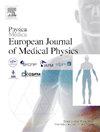Dual biomarkers CT-based deep learning model incorporating intrathoracic fat for discriminating benign and malignant pulmonary nodules in multi-center cohorts
IF 3.3
3区 医学
Q1 RADIOLOGY, NUCLEAR MEDICINE & MEDICAL IMAGING
Physica Medica-European Journal of Medical Physics
Pub Date : 2025-01-01
DOI:10.1016/j.ejmp.2024.104877
引用次数: 0
Abstract
Background
Recent studies in the field of lung cancer have emphasized the important role of body composition, particularly fatty tissue, as a prognostic factor. However, there is still a lack of practice in combining fatty tissue to discriminate benign and malignant pulmonary nodules.
Purpose
This study proposes a deep learning (DL) approach to explore the potential predictive value of dual imaging markers, including intrathoracic fat (ITF), in patients with pulmonary nodules.
Methods
We enrolled 1321 patients with pulmonary nodules from three centers. Image feature extraction was performed on computed tomography (CT) images of pulmonary nodules and ITF by DL, multimodal information was used to discriminate benign and malignant in patients with pulmonary nodules.
Results
Here, the areas under the receiver operating characteristic curve (AUC) of the model for ITF combined with pulmonary nodules were 0.910(95 % confidence interval [CI]: 0.870–0.950, P = 0.016), 0.922(95 % CI: 0.883–0.960, P = 0.037) and 0.899(95 % CI: 0.849–0.949, P = 0.033) in the internal test cohort, external test cohort1 and external test cohort2, respectively, which were significantly better than the model for pulmonary nodules. Intrathoracic fat index (ITFI) emerged as an independent influencing factor for benign and malignant in patients with pulmonary nodules, correlating with a 9.4 % decrease in the risk of malignancy for each additional unit.
Conclusion
This study demonstrates the potential auxiliary predictive value of ITF as a noninvasive imaging biomarker in assessing pulmonary nodules.
基于ct的双生物标志物深度学习模型结合胸内脂肪在多中心队列中鉴别良性和恶性肺结节。
背景:最近在肺癌领域的研究强调了身体成分,特别是脂肪组织作为预后因素的重要作用。然而,结合脂肪组织鉴别肺结节良恶性的实践尚缺乏。目的:本研究提出了一种深度学习(DL)方法,探讨包括胸内脂肪(ITF)在内的双重影像学标志物在肺结节患者中的潜在预测价值。方法:我们从三个中心招募了1321例肺结节患者。通过DL对肺结节和ITF的CT图像进行图像特征提取,利用多模态信息鉴别肺结节的良恶性。结果:ITF合并肺结节模型的受试者工作特征曲线下面积(AUC)在内测队列、外测队列1和外测队列2中分别为0.910(95%可信区间[CI]: 0.870 ~ 0.950, P = 0.016)、0.922(95% CI: 0.883 ~ 0.960, P = 0.037)和0.899(95% CI: 0.849 ~ 0.949, P = 0.033),均显著优于肺结节模型。胸内脂肪指数(ITFI)是肺结节患者良性和恶性的独立影响因素,每增加一个单位,恶性风险降低9.4%。结论:本研究证明了ITF作为一种无创成像生物标志物在评估肺结节中的潜在辅助预测价值。
本文章由计算机程序翻译,如有差异,请以英文原文为准。
求助全文
约1分钟内获得全文
求助全文
来源期刊
CiteScore
6.80
自引率
14.70%
发文量
493
审稿时长
78 days
期刊介绍:
Physica Medica, European Journal of Medical Physics, publishing with Elsevier from 2007, provides an international forum for research and reviews on the following main topics:
Medical Imaging
Radiation Therapy
Radiation Protection
Measuring Systems and Signal Processing
Education and training in Medical Physics
Professional issues in Medical Physics.

 求助内容:
求助内容: 应助结果提醒方式:
应助结果提醒方式:


